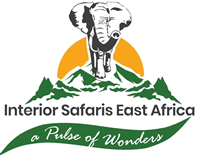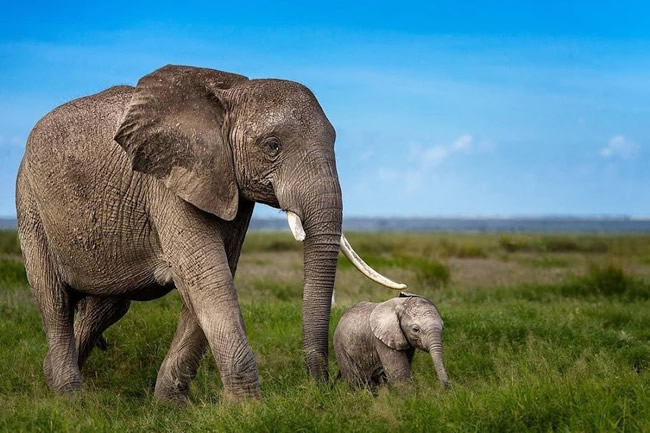In 1979, Queen Elizabeth National Park was designated as a biosphere reserve with the furthest objective of harmonizing human activities with the conservation and protection of wild life, wetlands and natural resources. There are eleven fishing village enclaves within the protected area. The ethnic groups surrounding this area are; Banyankole, Bakiga, Banyaruguru and Bakonzo.
From the open savannah to rainforest, from dense papyrus swamps and brooding crater lakes to the vastness of Lake Edward It is little wonder queen Elizabeth national park boasts of one of the highest biodiversity rating of any game park or reserve. Almost 100mammal species and a remarkable 606 bird species makes this superb safari territory , with elephants a profusion of hippos the elusive giant forest hog and handsome Uganda kob are often spotted around the tourist village of the Mweya peninsular which also boasts of a marvelous water front setting in the shadow of the Rwenzori mountains.
Uganda’s most popular national park: queen Elizabeth National Park was gazette in 1952 the same time as Murchison falls National Park as Uganda’s second largest covering an area of 1978kmsq. The park stretches from the crater dotted foot hills of the Rwenzori mountain range in the north along the shores of Lake Edward to the remote Ishasha River in the south. It stands on an elevation of between 1000-1800m a.s.l.as Its habitat is medium altitude moist semi deciduous forest, moist thicket, riparian forest, riverine bush land, open woodland, open grassland, seasonal and permanent swamps, lakes and rivers.
As well as its outstanding wildlife attraction, Queen Elizabeth National Park has fascinating cultural history. There are many opportunities for visitors to meet the local communities and enjoy storytelling, dance, music and more.
Elsewhere the remote Ishasha sector is famed for its tree climbing lions,
Kyambura gorge: Located on the North-Eastern side of QENP, is approximately 30 km from QENP Headquarters. Kyambura Gorge spans a distance of 16 km and links to the Kazinga Channel, which forms the northern boundary of the reserve. Village and plantations lie to the south. The reserve’s mean altitude is 1100 meters above the sea level. The total area of the reserve is 156 sq. km.
The kyambura gorge also known as the valley of apes harbors habituated chimps, and other types of primates including red-tailed monkey, black-and-white colobus, baboons and vervet monkeys. The maramagambo forest is home to an alluring selection of forest monkeys and birds and flocks of flamingoes are residents on the crater lakes Kyambura Game Reserve, also known as Kyambura Gorge, is part of the Queen Elizabeth National Park (QENP) in Uganda. It is home to a variety of wildlife, including the only primates in the Queen Elizabeth National Park. Kyambura Game Reserve was formed to serve as a buffer zone to the Queen Elizabeth National Park.
The Kazinga Channel: the 40km long water stripe that joins Lake Edward to Lake George has some of the most amazing display of wildlife and birds in queen Elizabeth National park. The amazing shore line of the channel attract a multitude of wild animals, birds, reptiles, with one of the largest schools of hippos in the world as well as plentiful Nile crocodiles. On a two hours launch cruise visitors can have a firsthand view of the numerous animals on the channel.
How to get there
Queen Elizabeth can be both accessed on road and by air. The tarmac road from Kampala via mbarara town and bushenyi leads to the Centre of the park passing just 22km from the south via mbarara covers a total of 420kms while the south via fort portal covers a distance of 410km
Charter flights can be arranged to existing airstrips of Kasese Mweya and Ishasha from Entebbe and Kajansi.
Game drives: For a classic African safari experience, the track through Kasenyi, the north kazinga plains and the Ishasha sector offer a virtually guaranteed buffaloes, antelopes, and elephant sightings along with warthogs and baboons. Taking an experienced guide in the early morning or dusk is the most successful way to track down a pride of lions and maybe even the odd leopard.
Boat cruise: The Kazinga channel is an oasis for many of the fascinating species that inhabit the park and taking a boat tour along it gives visitors the chance to cruise just meters from hundreds of enormous hippos and buffaloes while elephants linger on the shoreline
Birding: classified as an important birding area by the birding international, Queen Elizabeth’s great variety of bird habitats means it is home to over 600 species this is the greatest of all East Africa’s national park and a phenomenal number for such a small area the park’s confluence of savanna and forests of the DR Congo allows visitors to spot both east and central African species.
Chimp trekking: the kyambura gorge experience is more than discovering chimpanzees in their natural habitat. It teaches visitors about the eco system of the kyambura gorge’s atmospheric underground rainforest including vegetation types: bird identification and behavior: and chimp and monkey ecology.
Hiking and nature walks: nature walks are one of the most active ways of exploring the landscape and wildlife of queen Elizabeth National Park. Some other places in the park where one can quietly stroll with only the sound of glorious songs of birds is shady maramagambo forest, Mweya peninsula, with its scenic views and the Ishasha river where you may spot a number of savanna and forest species as well as having a great opportunity of getting close to the hippos.
People and culture: enjoy the energetic dances of the Kikorogo equator cultural performers, workers harvesting salt on the Katwe salt lake, and an agricultural and community tour of the bunyaruguru local community.
Apart from the above activities there are also visit to the bat cave tucked away in the thickly shady canopies of the maramagambo forest. The cave has a viewing room where visitors can treat themselves to an amazing site of resident’s bats and python. Also visitors who yearn to get up close to the animals and the fauna, can have a research tour for a rewarding adventure and also learn more about them. This unique experience allows visitors to actively participate in the monitoring of some exotic birds, and mammals that fill the park.
Facts about Queen Elizabeth National Park
The whole conservation area combined covers approximately 3000sq km that is with Kyambura and Kigezi wild life reserves. It receives an average maximum temperature of 28 degrees Celsius and 18 degrees Celsius. The park lies on an altitude range of 910 m at Lake Edward to 1845 m above sea level that is at the top of the escarpment of the western rift.
It is a habitat for a medium altitude moist semi-deciduous forest, riverine bush land,, moist thicket, riparian forest, open grassland, seasonal and permanent swamps, open woodland, lakes and rivers.
This place can be best timed from December – February and the tour can be for at least 2-3 days.
 Day 1: Morning Transfer to Lake Bunyonyi with enroute stop at the Equator for photographs, lunch in Mbarara, dinner and overnight at Arcadia cottages.Day 2: Morning boat ride to visit different Islands on the lake, visit Batwa people and enjoy the beautiful scenery of the place, return for early lunch and transfer to Bwindi Gorilla Forest, overnight at Gorilla Forest Camp / Silverback lodge Bwindi / Buhoma Rest camp.Day 3: Gorilla trekking adventure in Bwindi Forest, relax in the evening as you wait for dinner and overnight at the lodge.Day 4: Morning transfer to Queen Elizabeth wildlife park, enroute game drive through Ishasha sector, a home to tree climbing lions, lunch at Mweya Safari lodge, enjoy an afternoon launch cruise on Kazinga Channel, dinner and overnight at the Mweya safari lodge / Ihamba safari lodge / Simba Safari camp.Day 5: Enjoy a morning game drive through the park, return to the lodge for late breakfast and lunch, later embark on an afternoon game drive as we proceed to Fort portal. Dinner and overnight at Mountains of the Moon Hotel.Day 6: Morning visit to Amabere ga Nyinawiru cultural site, later transfer to Murchison falls National park, dinner and overnight at Paraa safari lodge / Sambiya River lodge / Red Chilli Camp .
Day 1: Morning Transfer to Lake Bunyonyi with enroute stop at the Equator for photographs, lunch in Mbarara, dinner and overnight at Arcadia cottages.Day 2: Morning boat ride to visit different Islands on the lake, visit Batwa people and enjoy the beautiful scenery of the place, return for early lunch and transfer to Bwindi Gorilla Forest, overnight at Gorilla Forest Camp / Silverback lodge Bwindi / Buhoma Rest camp.Day 3: Gorilla trekking adventure in Bwindi Forest, relax in the evening as you wait for dinner and overnight at the lodge.Day 4: Morning transfer to Queen Elizabeth wildlife park, enroute game drive through Ishasha sector, a home to tree climbing lions, lunch at Mweya Safari lodge, enjoy an afternoon launch cruise on Kazinga Channel, dinner and overnight at the Mweya safari lodge / Ihamba safari lodge / Simba Safari camp.Day 5: Enjoy a morning game drive through the park, return to the lodge for late breakfast and lunch, later embark on an afternoon game drive as we proceed to Fort portal. Dinner and overnight at Mountains of the Moon Hotel.Day 6: Morning visit to Amabere ga Nyinawiru cultural site, later transfer to Murchison falls National park, dinner and overnight at Paraa safari lodge / Sambiya River lodge / Red Chilli Camp .
Day 7: Morning game drive in search for African Lion, Leoprads, Elephants, Buffaloes and several antelope species, return for lunch and the lodge and later gather your strength for an afternoon launch cruise to the bottom of Murchison falls. Dinner and overnight at Paraa safari lodge.
Day 8: Have breakfast and take a brief game drive, later embark on a picnic drive back to Kampala to arrive by late afternoon.
END OF THE TOUR

